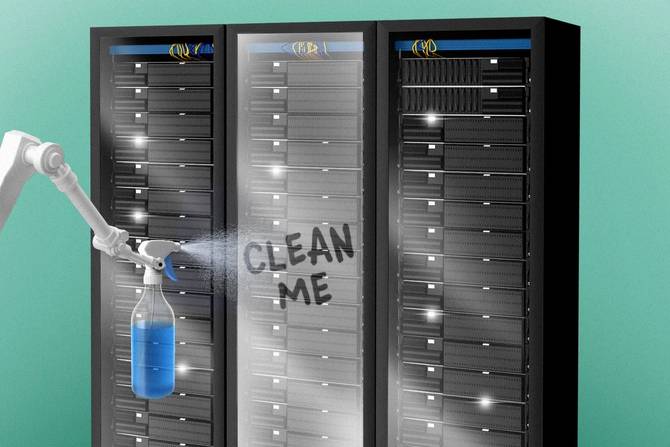It’s Monday! More importantly, it’s July 10. And you know what that means: You’re less than 24 hours away from free slurpees.
In today’s edition:
 Programmed Predator Programmed Predator
 Shift key Shift key
 Worked over Worked over
—Tom McKay, Eoin Higgins, Patrick Lucas Austin
|
|
Francis Scialabba
Researchers with Cisco Talos Intelligence Group have been able to peer into the inner workings of the mercenary surveillance spyware Predator, and it appears there’s something out there waiting for us, and it ain’t no man. It’s malware—and it’s very versatile.
Predator is a product of Cytrox, reportedly a partner in a joint spyware venture called Intellexa, which was formed by various vendors to compete with the notorious NSO Group. Like NSO’s Pegasus, it has nefarious capabilities, ranging from recording calls and secretly activating a device’s mic to snatching data from encrypted messaging apps and arbitrary code execution.
In May 2022, Google researchers found that both Predator and Alien, another malware component of the attack chain, relied on five separate zero-day exploits in Chrome and Android to spread, and were involved in at least three separate spyware campaigns. In their report, Talos researchers wrote that their analysis of malware samples had provided “proof that Alien is much more than just a loader for Predator as previously thought to be,” with Alien instead gaining access to “the low-level capabilities needed for Predator to spy on its victims.”
The two components specifically work in tandem to bypass SELinux, the security architecture that protects socket access in Android. According to the Talos report, Alien is smuggled into memory space normally used for zygote64, Android’s 64-bit initialization process, and gains various high-level privileges as a result. It then downloads or updates Predator, hiding communications between spyware components within legitimate system processes and receiving Predator’s commands, all outside SELinux’s notice.
Read more here.—TM
Do you work in IT or have information about your IT department you want to share? Email [email protected]. Want to go encrypted? Ask Tom for his Signal.
|
|
TOGETHER WITH SCHNEIDER ELECTRIC
|
The dreaded D-word? Yes, the IT department knows it all too well. Downtime is often caused by uninterruptible power supply (UPS) setups that are limited, unstaffed, clunky, and costly, making power events a truly heavy challenge to lift.
Until now. Schneider Electric’s APC Smart-UPS 3kW is the industry’s first 3kW 1U single-phase UPS. That’s right: This bad boy is designed to deliver more power, flexibility, and intelligent monitoring with a teensy-tiny footprint. It’s also the smallest, lightest, and most powerful 3kW UPS.
That’s not all, though. The APC Smart-UPS 3kW reduces the number of techs needed for install and saves tons of IT space. Aaand it’s all backed by lithium-ion batteries that are 3x more durable than lead-acid (VRLA) batteries.
Ditch the D-word and start packing a power punch at half the size.
|
|
Cisco
One Cisco team is working on the future as an internal “startup” within the networking administration company.
Cisco’s Outshift team aims to offer Cisco customers and partners more innovative and forward-looking solutions, the incubation engine’s SVP Vijoy Pandey told IT Brew at Cisco Live in early June. That’s done by developing and marketing new products and technologies that are outside the scope of Cisco’s main mission.
“As an incubation engine, we are looking at things end to end,” Pandey said. “So, we’ve got product engineering, marketing, sales, customer success, all within this organization.”
The plan. Pandey, who has been with Cisco for five years and involved with innovation and incubation throughout, has led the Outshift iteration of the company’s incubation engine since February.
Outshift officially debuted at Cisco Live with the release of a new suite of tools for Panoptica, Cisco’s cloud security development platform. Pandey and his team aren’t interested in consumer products and operations so much as providing tools—like Panoptica—for developers and companies. It’s B2B, not managing personal phones or headsets, he explained.
“We are looking at manufacturing floors, we’re looking at retail store environments, we’re looking at connected cars,” Pandey said. “To us, that’s still human to device, but it’s in a B2B context.”
Big data. For data management, that means finding the niche where businesses aren’t being served. Management, compliance, and other data problems are difficult; difficulties compounded by operating within cloud environments and, something that should be familiar to IT teams, a lack of tech savvy among many users within organizations and companies.
Keep reading here.—EH
Do you work in IT or have information about your IT department you want to share? Email [email protected].
|
|
Dimitri Otis/Getty Images
Long hours and staff shortages are increasingly defining the tech job market.
That’s according to recent studies from Kaseya and CyberSeek, which found that IT professionals are working long hours to hit goals, as the industry is having trouble making up a sizable labor shortage in the cybersecurity sector alone.
Kaseya’s report surveyed 1,318 IT professionals, the majority—89%—from the Americas. Respondents primarily worked in software and hardware development, manufacturing, healthcare, education, and financial services; half were in leadership positions.
Of those surveyed, 62% reported having to work holidays and weekends, 46% reported pulling all-nighters, and 39% said they had worked consecutive 50+ hour weeks.
“The discontent with work-life balance is front and center,” the report’s authors wrote. “In response to a question about how they feel about it, three out of four respondents expressed a lack of optimism and enthusiasm. Conversely, only 26% of respondents considered their work-life balance to be good.”
Given the shortfall between open tech jobs and the number of people available to fill them, that overwork is perhaps unsurprising. CyberSeek, a joint initiative of the National Institute of Standards and Technology’s NICE program, Lightcast, and CompTIA, estimates that the cybersecurity job shortfall stands at 466,225.
CyberSeek’s data, accessible via the site’s heatmap, found the supply-demand ratio stands at 69%—i.e., 69 workers for every 100 postings—with 663,434 cybersecurity openings posted from May 2022 through April 2023. CyberSeek’s study comes on the heels of May’s jobs numbers, which showed tech hiring as a whole up by 45,000 jobs across the economy, even as the sector lost 4,725 jobs.—EH
Do you work in IT or have information about your IT department you want to share? Email [email protected].
|
|
TOGETHER WITH CISCO SECURE
|
|
Secure your bucks. Here’s a dynamic duo for ya: defense and dough. No, really—strong security measures = strong money measures. That’s why Cisco just published a new report on the economic impact of Cisco Secure Firewall, their defense system that can achieve 195% risk-adjusted ROI. Read the report.
|
|
Francis Scialabba
Today’s top IT reads.
Stat: $60,000. That’s the cost of the Sondek LP12-50, a record player designed by ex-Apple designer Jony Ive. (PCMag)
Quote: “If these AI [chatbots] can’t even do something as basic as put a Star Wars movie in order one after the other, I don’t think you can trust it to [report] any kind of accurate information.”—Gizmodo Deputy Editor James Whitbrook on parent company G/O Media’s decision to use AI to write an article, which contained factual errors (the Washington Post)
Read: With Evernote laying off most of its US staff, here’s how to transfer your precious data. (The Verge)
Trust is a must: Especially when it comes to device security. Kolide’s device trust solution helps teams with Okta achieve 100% compliance with internal standards. Watch their on-demand demo to learn more.*
*This is sponsored advertising content.
|
|
|








